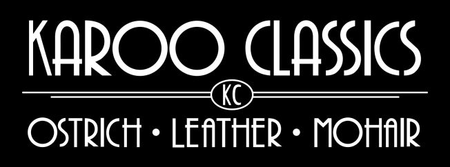Is ostrich leather an exotic skin?
Is Ostrich Leather regarded as exotic?
In our previous blogs we learned that ostrich leather is something that is truly African and indigenous. With all of these interesting facts, we came to the knowledge that ostrich leather is one of the strongest leathers in the world, second to kangaroo skin. But something we have not looked at is why this bird’s skin is considered as an exotic leather. It could explain why it is significantly more expensive when compared to many other leathers…
Let’s look into the big WHY and find out!
Just like other exotic skins, ostrich is a small-area skin compared to bovine and horse hides, and is ranked by the follicles per area since they thin out further away from the neck. It is processed consequently in a more particular way to preserve the largest possible area for processing and treatments, and is put through more than 30 stages related to this.
Per unit it is comparable to goat and sheep skins and the range of equipment used is about the same. For this reason, the smaller units, smaller batches, subsequent longer tanning times and skills, increase the cost, elevating it to a luxury product.
Known as the diamond (central area of the skin), it divided up into 4 quarters, the skin is then graded according to the amount of markings in each quarter. These four quarters are generally known to be the areas where the most valuable pieces of skin will come from. The ‘diamond’ will then be used for handbags and what is left of the skin when you get closer to the neck with smaller quills would be used for accessories and assorted ostrich leather small items. This means that when an ostrich handbag is in production, it could take up to two ostrich skins to supply the correct amount of quills and thickness to make that perfectly handcrafted handbag.
Chemical measurements must be precise to always avoid mistakes and waste to produce a beautiful and flawless, finished skin. Skins are marked and tagged, production takes time and quality standards are high. Lime is added, removed and redone after days of processing and expert clipping prevents skins from tangling with each other. Natural pigmentation is bleached out of the skin, there is tanning and more tanning with mould prevention along the way. A well-finished hide necessarily receives high-quality colours and finishing dyes to industry and market standards.
The average size of a prepared ostrich skin which can be used with success in most applications is around 16 square feet (1.5 m2). The size and thickness of the skin, as well as follicle development is influenced by maturity of development of the birds at the time of slaughter. This varies depending on production methods.
The production process is tabulated in three stages: raw, crust, and finished product. At the first stage, the raw materials are pre-soaked, then cleaned, fleshed and picked over several times, trimmed, weighed chrome-tanned using very specific chemicals as well as other chromium salts; and so on, involving 15 steps, the last being the "wet blue" product where it is wrung and set out.
The second, or crust stage involves 10 steps, with side trimming and finer cutting, dyeing and drying to produce "crust" leather product. This when it is measured, after drying. The third stage of "finishing" ostrich leather begins with conditioning to soften it, staking, and other applications making eleven steps, including grading, measuring and packing. So much more to it than what we thought, right?
Because it is expensive and time consuming to manufacture all three processes and it takes specific and expensive machinery - countries that produce ostrich skins on a smaller scale, export them at the "raw" and "crust" stages. South Africa is an important processor of finished skins for the main leather manufacturers in Japan. Other African countries engaged in ostrich skin processing are Zimbabwe, Namibia and Botswana. Botswana markets directly to South African tanneries.
South African tanneries receives about 200,000 skins a year from the ostrich farmers and abattoirs of the region and from elsewhere in the world it receives around 15,000 skins. South African tanneries export around 90% of its finished leather to manufacturers in Europe and East Asia where it is made into gloves, wallets, handbags, shoes, luggage, upholstery and sports goods. The remaining 10% goes to South African manufacturers of the same range of items.
All these facts are vital to keep in mind when you shop for ostrich items next time. It goes to show how much effort, time and precision goes into that beautiful handbag or belt that you love so much. It is also the reason why it will last you many years!
Sample Block Quote
Praesent vestibulum congue tellus at fringilla. Curabitur vitae semper sem, eu convallis est. Cras felis nunc commodo loremous convallis vitae interdum non nisl. Maecenas ac est sit amet augue pharetra convallis nec danos.
Sample Paragraph Text
Praesent vestibulum congue tellus at fringilla. Curabitur vitae semper sem, eu convallis est. Cras felis nunc commodo eu convallis vitae interdum non nisl. Maecenas ac est sit amet augue pharetra convallis nec danos dui.
Cras suscipit quam et turpis eleifend vitae malesuada magna congue. Damus id ullamcorper neque. Sed vitae mi a mi pretium aliquet ac sed elitos. Pellentesque nulla eros accumsan quis justo at tincidunt lobortis denimes loremous. Suspendisse vestibulum lectus in lectus volutpat, ut dapibus purus pulvinar. Vestibulum sit amet auctor ipsum.
